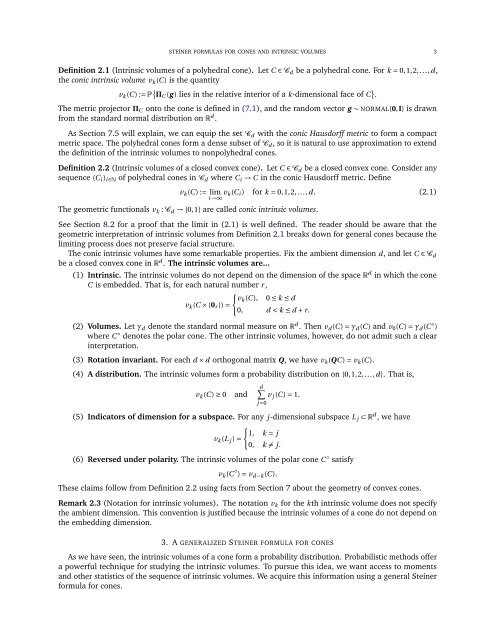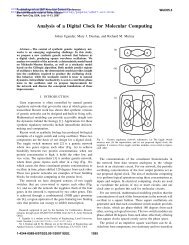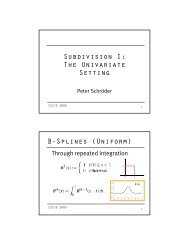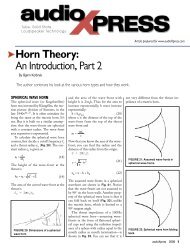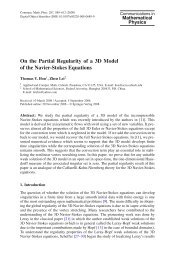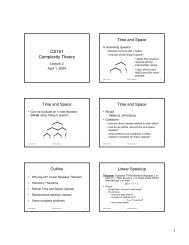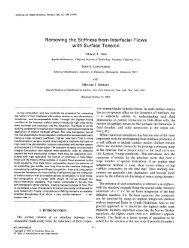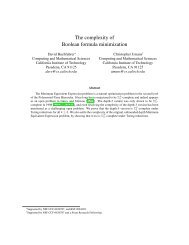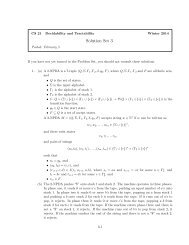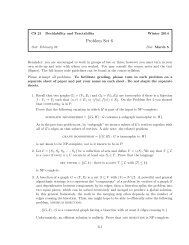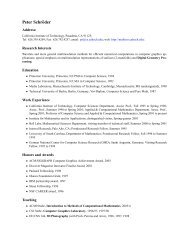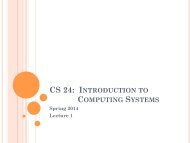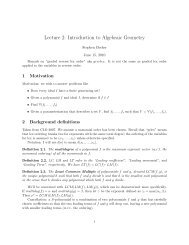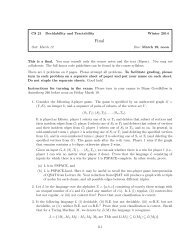From Steiner formulas for cones to concentration of intrinsic volumes
From Steiner formulas for cones to concentration of intrinsic volumes
From Steiner formulas for cones to concentration of intrinsic volumes
You also want an ePaper? Increase the reach of your titles
YUMPU automatically turns print PDFs into web optimized ePapers that Google loves.
STEINER FORMULAS FOR CONES AND INTRINSIC VOLUMES 3Definition 2.1 (Intrinsic <strong>volumes</strong> <strong>of</strong> a polyhedral cone). Let C ∈ C d be a polyhedral cone. For k = 0,1,2,...,d,the conic <strong>intrinsic</strong> volume v k (C) is the quantityv k (C) := P { Π C (g ) lies in the relative interior <strong>of</strong> a k-dimensional face <strong>of</strong> C } .The metric projec<strong>to</strong>r Π C on<strong>to</strong> the cone is defined in (7.1), and the random vec<strong>to</strong>r g ∼ NORMAL(0,I) is drawnfrom the standard normal distribution on R d .As Section 7.5 will explain, we can equip the set C d with the conic Hausdorff metric <strong>to</strong> <strong>for</strong>m a compactmetric space. The polyhedral <strong>cones</strong> <strong>for</strong>m a dense subset <strong>of</strong> C d , so it is natural <strong>to</strong> use approximation <strong>to</strong> extendthe definition <strong>of</strong> the <strong>intrinsic</strong> <strong>volumes</strong> <strong>to</strong> nonpolyhedral <strong>cones</strong>.Definition 2.2 (Intrinsic <strong>volumes</strong> <strong>of</strong> a closed convex cone). Let C ∈ C d be a closed convex cone. Consider anysequence (C i ) i∈N <strong>of</strong> polyhedral <strong>cones</strong> in C d where C i → C in the conic Hausdorff metric. Definev k (C) := limi→∞v k (C i ) <strong>for</strong> k = 0,1,2,...,d. (2.1)The geometric functionals v k : C d → [0,1] are called conic <strong>intrinsic</strong> <strong>volumes</strong>.See Section 8.2 <strong>for</strong> a pro<strong>of</strong> that the limit in (2.1) is well defined. The reader should be aware that thegeometric interpretation <strong>of</strong> <strong>intrinsic</strong> <strong>volumes</strong> from Definition 2.1 breaks down <strong>for</strong> general <strong>cones</strong> because thelimiting process does not preserve facial structure.The conic <strong>intrinsic</strong> <strong>volumes</strong> have some remarkable properties. Fix the ambient dimension d, and let C ∈ C dbe a closed convex cone in R d . The <strong>intrinsic</strong> <strong>volumes</strong> are...(1) Intrinsic. The <strong>intrinsic</strong> <strong>volumes</strong> do not depend on the dimension <strong>of</strong> the space R d in which the coneC is embedded. That is, <strong>for</strong> each natural number r ,{vk (C), 0 ≤ k ≤ dv k (C × {0 r }) =0, d < k ≤ d + r.(2) Volumes. Let γ d denote the standard normal measure on R d . Then v d (C) = γ d (C) and v 0 (C) = γ d (C ◦ )where C ◦ denotes the polar cone. The other <strong>intrinsic</strong> <strong>volumes</strong>, however, do not admit such a clearinterpretation.(3) Rotation invariant. For each d × d orthogonal matrix Q, we have v k (QC) = v k (C).(4) A distribution. The <strong>intrinsic</strong> <strong>volumes</strong> <strong>for</strong>m a probability distribution on {0,1,2,...,d}. That is,v k (C) ≥ 0andd∑v j (C) = 1.(5) Indica<strong>to</strong>rs <strong>of</strong> dimension <strong>for</strong> a subspace. For any j-dimensional subspace L j ⊂ R d , we have{1, k = jv k (L j ) =0, k ≠ j.(6) Reversed under polarity. The <strong>intrinsic</strong> <strong>volumes</strong> <strong>of</strong> the polar cone C ◦ satisfyj =0v k (C ◦ ) = v d−k (C).These claims follow from Definition 2.2 using facts from Section 7 about the geometry <strong>of</strong> convex <strong>cones</strong>.Remark 2.3 (Notation <strong>for</strong> <strong>intrinsic</strong> <strong>volumes</strong>). The notation v k <strong>for</strong> the kth <strong>intrinsic</strong> volume does not specifythe ambient dimension. This convention is justified because the <strong>intrinsic</strong> <strong>volumes</strong> <strong>of</strong> a cone do not depend onthe embedding dimension.3. A GENERALIZED STEINER FORMULA FOR CONESAs we have seen, the <strong>intrinsic</strong> <strong>volumes</strong> <strong>of</strong> a cone <strong>for</strong>m a probability distribution. Probabilistic methods <strong>of</strong>fera powerful technique <strong>for</strong> studying the <strong>intrinsic</strong> <strong>volumes</strong>. To pursue this idea, we want access <strong>to</strong> momentsand other statistics <strong>of</strong> the sequence <strong>of</strong> <strong>intrinsic</strong> <strong>volumes</strong>. We acquire this in<strong>for</strong>mation using a general <strong>Steiner</strong><strong>for</strong>mula <strong>for</strong> <strong>cones</strong>.


